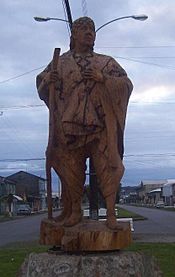Nueva Imperial facts for kids
Quick facts for kids
Nueva Imperial
|
|||||
|---|---|---|---|---|---|

Monument to Cacique Lemunao in Nueva Imperial
|
|||||
|
|||||
| Country | Chile | ||||
| Region | Araucanía | ||||
| Province | Cautín | ||||
| Founded | 1551 | ||||
| Government | |||||
| • Type | Municipality | ||||
| Area | |||||
| • Total | 732.5 km2 (282.8 sq mi) | ||||
| Elevation | 20 m (70 ft) | ||||
| Population | |||||
| • Total | 29,366 | ||||
| • Density | 40.090/km2 (103.833/sq mi) | ||||
| • Urban | 18,335 | ||||
| • Rural | 21,724 | ||||
| Sex | |||||
| • Men | 20,423 | ||||
| • Women | 19,636 | ||||
| Time zone | UTC−4 (CLT) | ||||
| • Summer (DST) | UTC−3 (CLST) | ||||
| Area code(s) | country + city = 56 + 45 | ||||
| Climate | Csb | ||||
| Website | Municipality of Nueva Imperial | ||||
Nueva Imperial (which means "New Imperial" in English) is a city and commune in southern Chile. It is part of Cautín Province in the Araucanía Region. Nueva Imperial is about 35 km (22 mi) west of Temuco, the main city of the region.
Contents
Geography and Nature
Nueva Imperial is in a beautiful area. It has many natural wonders. You can find volcanoes, mountains, and rivers. There are also hot springs and green valleys. Old native forests grow here. Some even have araucaria trees.
Two rivers flow through the city. These are the Chol-Chol and Cautín Rivers. They join to form the Imperial River. The Imperial River then flows into the Pacific Ocean at Puerto Saavedra. You can use boats on these rivers. People also enjoy fishing for trout and other fish. Canoeing and kayaking are popular activities too.
History of Nueva Imperial
Founding and Early Days
The city we know as Nueva Imperial was first started in 1551. Pedro de Valdivia, a Spanish conquistador, founded it. He named it La Imperial. Valdivia wanted it to be a very important city in colonial Chile. He even thought it might become the country's capital.
However, the local people, called the Mapuche, attacked the city. They destroyed it two times. Because of these attacks, La Imperial was completely left empty in 1599.
Rebirth of the City
In 1882, a new city was built nearby. It was called Carahue. In the Mapudungun language, this name means "The City that Was." In the same year, Imperial was refounded. It was built about 12 miles from its first location. This new city was named Nueva Imperial, meaning "New Imperial." About 8 miles from Nueva Imperial, you can still find parts of an old Spanish fort called Boroa.
Chief Lemunao's Legacy
The leader of the people in this area was a chief named Lemunao. He sold the land that later became Nueva Imperial to the Spanish. Today, there is a wooden monument to him. It stands 6.5 feet tall. You can see it at the edge of the city.
Population and People
According to a 2002 census, Nueva Imperial covers an area of 1,160.4 km2 (448 sq mi). It had 40,059 people living there. This included 20,423 men and 19,636 women. About 18,335 people (45.8%) lived in urban areas. The other 21,724 people (54.2%) lived in rural areas. The population grew a lot between 1992 and 2002. It increased by 44.8%, which is 12,387 more people.
Nueva Imperial has one of the largest groups of indigenous people in the region. This means it's a great place to learn about the Mapuche culture. You can discover their language, traditions, arts, crafts, and food.
Unique Features of Nueva Imperial
One of the city's most famous sights is its bridge. It was first built for trains. Now, it is kept because it is so beautiful. The famous architect and engineer Gustave Eiffel designed it.
Nueva Imperial is also known for its colorful houses. Because of these houses, it was once called "The Watercolor City." The city is growing and becoming more urban. More people are moving here because there are more jobs and businesses.
Nueva Imperial is actually made up of two parts. There is Imperial itself and a village called Villa Almagro. Villa Almagro is named after another Spanish conquistador, Diego de Almagro. It is located on the other side of the Chol Chol River. The poet Juvencio Valle was born in Villa Almagro. He won a national literature prize in Chile. His house is still there. The Araucanía Region also inspired the famous poet Pablo Neruda, who grew up nearby. Together, Imperial and Villa Almagro have about 40,000 people.
The city is also divided by a big hill. The part of the city at the bottom of the hill is called El Bajo ("lower"). The part at the top is called El Alto ("upper"). From the top of the hill, you can see amazing views. You can spot the volcanoes Villarrica, Llaima, and Lonquimay. You can also see the beautiful countryside around them.
Local Celebrations and Holidays
Mapuche New Year
The Mapuche people celebrate their new year on June 24. This holiday is called Wuetripantu. Traditionally, people drink a grain alcohol called mudai during this celebration.
Imperial Week and National Holidays
The last week of February is "Imperial Week." This week ends with a big fireworks show over the river. Another important date is September 18. This day celebrates the first Government Junta of Chile. It is called "Fiestas Patrias" and is a national holiday.
See also
 In Spanish: Nueva Imperial para niños
In Spanish: Nueva Imperial para niños





